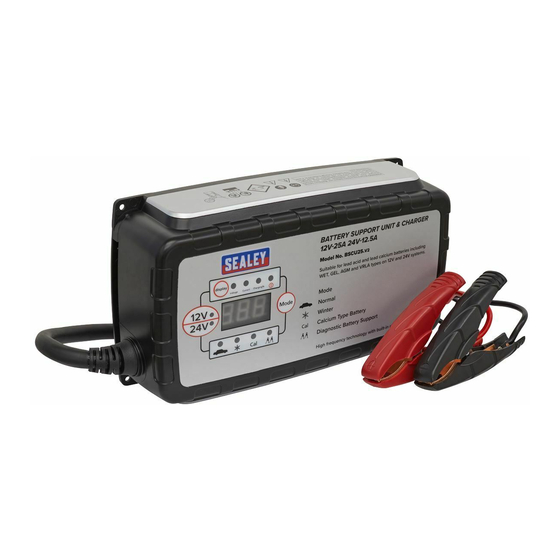
Advertisement
Quick Links
Thank you for purchasing a Sealey product. Manufactured to a high standard this product will give you years of trouble free performance if these instructions are
carefully followed and the product is correctly maintained.
IMPORTANT: PLEASE READ THESE INSTRUCTIONS CAREFULLY. NOTE THE SAFE OPERATIONAL REQUIREMENTS, WARNINGS AND CAUTIONS. USE THIS
PRODUCT CORRECTLY AND WITH CARE FOR THE PURPOSE FOR WHICH IT IS INTENDED. FAILURE TO DO SO MAY CAUSE DAMAGEAND/OR PERSONAL
INJURY AND WILL INVALIDATE THE WARRANTY. PLEASE RETAIN THESE INSTRUCTIONS FOR FUTURE USE.
1. SAFETY INSTRUCTIONS
THE FOLLOWING STATEMENTS ON ELECTRICAL SAFETY MUST bE READ AND UNDERSTOOD bEFORE USING THE CHARGER.
1.1.
ELECTRICAL SAFETY. WARNING! It is the user's responsibility to check the following:
You must check all electrical equipment and appliances to ensure they are safe before using. You must inspect power supply leads,
plugs and all electrical connections for wear and damage. You must ensure the risk of electric shock is minimised by the installation of
appropriate safety devices. An RCCB (Residual Current Circuit Breaker) should be incorporated in the main distribution board.
We recommend that an RCD (Residual Current Device) is used with all electrical products. It is particularly important to use an RCD
with portable products that are plugged into an electrical supply not protected by an RCCB. If in doubt consult a qualified electrician.
You may obtain a Residual Current Device by contacting your Sealey dealer. You must also read and understand the following
instructions concerning electrical safety.
1.1.1. The Electricity At Work Act 1989 requires all portable electrical appliances, if used on business premises, to be tested by a qualified
person, using a Portable Appliance Tester (PAT), at least once a year.
1.1.2. The Health & Safety at Work Act 1974 makes owners of electrical appliances responsible for the safe condition of the appliance and
the safety of the appliance operator. If in any doubt about electrical safety, contact a qualified electrician.
1.1.3. DO ensure the insulation on all cables and the product itself is safe before connecting to the mains power supply. See 1.2.1. above
and use a Portable Appliance Tester (PAT).
1.1.4. DO ensure that cables are always protected against short circuit and overload.
1.1.5. DO regularly inspect power supply, leads, plugs for wear and damage and all electrical connections to ensure that none is loose.
1.1.6. DO check that the voltage marked on the product is the same as the electrical power supply to be used and check that all fused plugs
are fitted with the correct capacity fuse.
1.1.7. DO NOT pull or carry the powered appliance by its power supply lead and do not pull plug by the cable. Products must not be pulled
or carried by their output cables.
1.1.8. DO NOT use worn or damage leads, plugs or connections. Immediately replace or repair by a qualified
electrician.
1.1.9. If an extension reel is used, it must be fully unwound before connection to an RCD protected circuit. The
cable core must be a minimum of 1.5mm².
1.1.10. Important: Ensure that the voltage marked on the appliance matches the power supply to be used and
that the plug is fitted with the correct fuse - see fuse rating below. When a BS 1363/A UK 3 pin plug is
damaged, cut the cable just above the plug and dispose of the plug safely. Fit a new plug according
to the following instructions (UK only).
a) Connect the GREEN/YELLOW earth wire to the earth terminal 'E'.
b) Connect the bROWN live wire to the live terminal 'L'.
c) Connect the bLUE neutral wire to the neutral terminal 'N'.
d) After wiring, check that there are no bare wires, that
all wires have been correctly connected, that the cable outer insulation extends
beyond the cable restraint and that the restraint is tight.
Double insulated products, which are always marked with this symbol
live (brown) and neutral (blue) wires only. To rewire, connect the wires as indicated in diagram.
DO NOT connect either wire to the earth terminal.
© Jack Sealey Limited 2013
INSTRUCTIONS FOR:
bATTERY SUPPORT UNIT & CHARGER
12V-25A 24V-12.5A
MODEL No: bSCU25
, are fitted with
Original Language Version
fig.1
RECOMMENDED
FUSE RATING
5AMP
fig.2
BSCU25
Issue: 1 -27/06/13
Advertisement

Summary of Contents for Sealey BSCU25
- Page 1 12V-25A 24V-12.5A MODEL No: bSCU25 Thank you for purchasing a Sealey product. Manufactured to a high standard this product will give you years of trouble free performance if these instructions are carefully followed and the product is correctly maintained. IMPORTANT: PLEASE READ THESE INSTRUCTIONS CAREFULLY. NOTE THE SAFE OPERATIONAL REQUIREMENTS, WARNINGS AND CAUTIONS. USE THIS PRODUCT CORRECTLY AND WITH CARE FOR THE PURPOSE FOR WHICH IT IS INTENDED.
-
Page 2: General Safety Instructions
4.1.2. If the battery is removed, place in an appropriate safe area, according to Section 1, ready for charging. 4.1.3. A boat battery must be removed and charged on shore. Original Language Version © Jack Sealey Limited 2013 BSCU25 Issue: 1 - 27/06/13... - Page 3 Return the battery to the vehicle, if required, secure according the manufacturer’s instructions and re-connect the power leads. Check to ensure all tools are removed before closing the bonnet. Original Language Version © Jack Sealey Limited 2013 BSCU25 Issue: 1 - 27/06/13...
- Page 4 3 - Soft start 4 - Pulse mode 5 - Recondition 6 - Bulk 7 - Absorption u(V) 8 - Equalisation 9 - Check Lead acid battery charge graphical representation Original Language Version © Jack Sealey Limited 2013 BSCU25 Issue: 1 - 27/06/13...
-
Page 5: Care And Maintenance
Keep the charger leads loosely coiled during storage without snagging or crushing. 5.4. DO NOT attempt to repair damaged leads, these must be replaced by your Sealey service agent or a qualified person. 5.5. DO NOT attempt to repair charger electronics, this must be done by your Sealey service agent or a qualified person.




